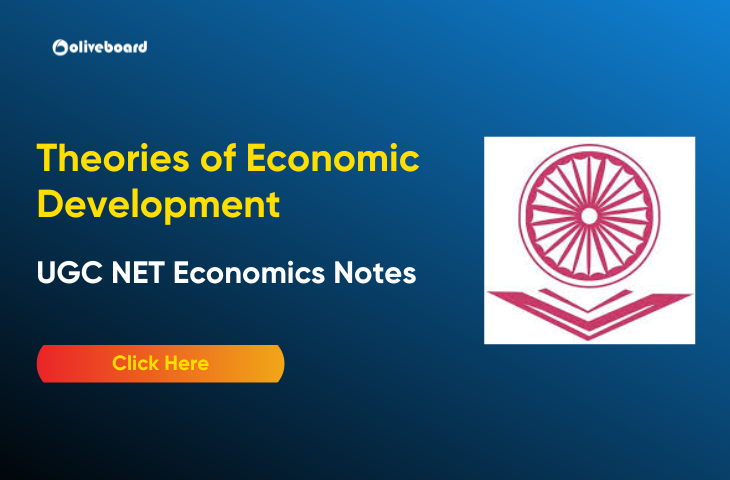Theories of Economic Development: Economic development has been a key focus in economics, with various theories proposing different pathways to growth. Classical economists like Adam Smith and David Ricardo laid the foundation with their ideas on the division of labor and comparative advantage. Karl Marx introduced a critical approach, emphasizing class struggles and capitalist dynamics. In the 20th century, Joseph Schumpeter focused on innovation and entrepreneurship, while Rostow’s Stages of Growth provided a model for understanding the sequential stages of development. These theories are essential for UGC NET Economics aspirants, providing a comprehensive understanding of economic development that is critical for exam preparation.
Classical Theories of Economic Development
The classical theories of economic development, primarily formulated by Adam Smith and David Ricardo, laid the foundation for modern economic thought, emphasizing the importance of markets, specialization, and trade in driving growth.
1. Adam Smith (1776): The Invisible Hand, Division of Labor, and Self-Interest
- Invisible Hand: In The Wealth of Nations (1776), Smith argued that individuals, by pursuing their self-interest, unintentionally contribute to the public good, fostering economic development through market competition.
- Minimal Government Intervention: Smith believed that limited government interference in the economy allows the market forces of supply and demand to efficiently allocate resources.
- Division of Labor:
- Smith highlighted that dividing production into specialized tasks increases productivity.
- The famous example of a pin factory demonstrated how specialization leads to more output.
- Self-Interest Drives Prosperity: Smith’s theory suggests that when individuals act out of self-interest, they contribute to societal wealth, promoting overall economic growth.
2. David Ricardo (1817): Comparative Advantage, Trade, and Specialization
- Comparative Advantage (1817):
- In On the Principles of Political Economy and Taxation, Ricardo developed the theory of comparative advantage, arguing that countries should specialize in producing goods where they have the least disadvantage, even if they are less efficient overall.
- Benefits of Specialization: By specializing in production, countries can trade with each other, increasing global output and fostering economic development.
- Free Trade: Ricardo’s theory emphasizes the benefits of free trade between nations, leading to a more efficient allocation of resources and a higher standard of living globally.
- Global Economic Growth: Ricardo’s ideas promoted the concept of international trade, where specialization leads to mutual benefits, boosting economic growth across countries.
Marxist Theory of Economic Development
The Marxist theory of economic development, formulated by Karl Marx in the 19th century, presents a critical approach to understanding economic growth, focusing on class struggle, capitalism, and exploitation as central drivers of historical change.
1. Karl Marx (1867): Class Struggle, Capitalist Dynamics, and Exploitation
- Class Struggle: In Das Kapital (1867), Marx argued that society is divided into two main classes:
- bourgeoisie (capitalists who own the means of production)
- proletariat (working class who sell their labor).
- The conflict between these classes drives societal and economic change.
- Capitalist Exploitation:
- Marx claimed that capitalism is exploitative, as the bourgeoisie profits by paying workers less than the value of what they produce.
- This exploitation leads to increased inequality and eventually undermines the system.
- Capital Accumulation: Capitalists seek to accumulate wealth by reinvesting profits, which Marx argued leads to economic crises and instability due to overproduction and falling profits.
2. Historical Materialism and the Stages of Economic Growth (1845-1859)
- Historical Materialism:
- Marx’s theory of historical materialism asserts that economic development is driven by material conditions rather than ideals or ideas.
- He believed that the mode of production determines the structure of society and its development over time.
- Stages of Economic Growth: Marx identified several stages of economic development, each defined by different modes of production:
- Primitive Communism: Early societies with communal ownership of resources.
- Slave Society: The emergence of private property and exploitation of slaves for economic gain.
- Feudalism: A system based on land ownership and serfdom, where lords controlled production.
- Capitalism: The rise of industrial production, capitalist markets, and class divisions.
- Socialism/Communism: Marx predicted that capitalism would eventually lead to a revolution, resulting in a socialist system where the proletariat would overthrow the bourgeoisie, leading to communal ownership of the means of production and the abolition of class distinctions.
Click here UGC NET Economics Syllabus December 2024
Schumpeter’s Theory of Economic Development
Joseph Schumpeter (1883-1950) focused on the role of innovation and entrepreneurship in economic development, with key concepts like creative destruction shaping modern economic thought.
1. Entrepreneurship and Innovation (1911)
- Entrepreneurs introduce innovations that disrupt markets and drive growth.
- Types of Innovation: New products, production methods, markets, materials, and organizational forms.
- Entrepreneurs are seen as the agents of economic transformation.
2. Creative Destruction (1942)
- Innovation leads to the destruction of outdated technologies, fostering new industries.
- This cycle of creative destruction is essential for long-term economic progress.
3. Role of Credit (1911)
- Credit is crucial for financing innovation and entrepreneurial ventures, enabling economic development.
Rostow’s Stages of Economic Growth
Walt Rostow (1916-2003) developed the Stages of Economic Growth model in his 1960 work The Stages of Economic Growth: A Non-Communist Manifesto. Rostow’s theory presents a linear progression of development, where countries move through five stages, from traditional societies to advanced economies.
1. Traditional Society (Pre-1700s)
- Agrarian economies with low productivity and resistance to change.
- Limited technological innovation and subsistence production.
2. Pre-Conditions for Take-Off (1700s-1800s)
- Technological and agricultural advancements create the foundation for industrialization.
- Development of transportation, markets, and financial systems.
3. Take-Off (Early to Mid-1800s)
- Rapid industrialization, technological innovation, and urbanization.
- Example: The Industrial Revolution in Britain, beginning in the late 18th century.
4. Drive to Maturity (Late 19th – Mid-20th Century)
- Sustained economic growth with technological diversification.
- Example: The rise of mass production techniques in the U.S. during the early 20th century.
5. Age of High Mass Consumption (Mid-20th Century Onwards)
- Shift to consumer-based economies with rising living standards.
- Focus on consumer goods and services, as seen in post-WWII economic booms.
Theory of Economic Development – Big Push Theory
The Big Push Theory, popularized by economists like Paul Rosenstein-Rodan (1943), suggests that large-scale, coordinated investments are necessary to overcome the barriers to development in underdeveloped countries.
1. Large, Coordinated Investment (1943)
- The theory argues that a critical mass of simultaneous investments across various sectors (such as infrastructure, education, and industries) is needed to stimulate growth.
- These investments help create economic linkages, where growth in one sector triggers development in others, creating a self-sustaining cycle.
2. Overcoming Development Bottlenecks
- Poor countries face multiple bottlenecks in areas like infrastructure, capital, and skilled labor.
- A “big push” can help overcome these challenges by addressing them all at once.
- Example: In the mid-20th century, planned industrialization strategies in countries like India and South Korea used large-scale investments to accelerate growth.
3. Focus on Coordination and Complementary Investments
- The theory stresses the importance of coordinated efforts and complementary investments in sectors such as transportation, education, and industry to generate economic momentum and avoid the vicious cycle of poverty.
Theory of Economic Development Conclusion
In conclusion, the theories of economic development offer essential insights for understanding the dynamics of economic growth. From Adam Smith’s market mechanisms and David Ricardo’s comparative advantage to Marx’s class struggle and Schumpeter’s innovation-driven growth, each theory highlights key factors like entrepreneurship, industrialization, and technological advancement. By exploring these theories, we better grasp how coordinated investments and policy interventions can foster sustainable economic development in both developed and developing nations.
Theories of Economic Development FAQs
Ans: The major theories of economic development include Classical Theories (Adam Smith and David Ricardo), Marxist Theory, Schumpeter’s Theory of Innovation, Rostow’s Stages of Growth, and the Big Push Theory.
Ans: Adam Smith’s theory emphasizes the role of self-interest, division of labor, and the Invisible Hand in fostering market efficiency and economic growth.
Ans: Schumpeter’s Theory highlights entrepreneurship as the key driver of economic development through innovation, leading to creative destruction where new industries replace outdated ones.
Ans: The Big Push Theory argues that large-scale investments in multiple sectors (like infrastructure and industry) are needed to overcome developmental bottlenecks and accelerate economic growth in underdeveloped countries.

Hello there! I’m a dedicated Government Job aspirant turned passionate writer & content marketer. My blogs are a one-stop destination for accurate and comprehensive information on exams like Regulatory Bodies, Banking, SSC, State PSCs, and more. I’m on a mission to provide you with all the details you need, conveniently in one place. When I’m not writing and marketing, you’ll find me happily experimenting in the kitchen, cooking up delightful treats. Join me on this journey of knowledge and flavors!
